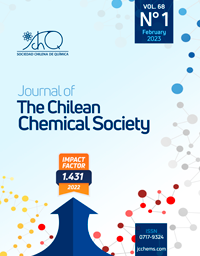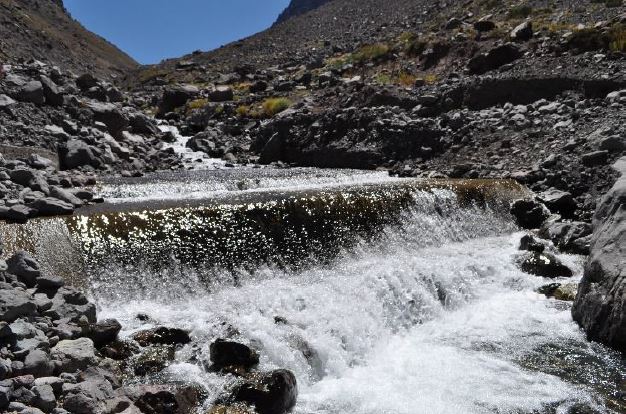PHYSICOCHEMICAL, ISOTOPIC, SPECTRAL, AND MICROBIOLOGICAL ANALYSES OF WATER FROM GLACIER MAPPA, CHILEAN ANDES

- Glacier water,
- Glacier Mapa,
- Andes Mountains,
- Chile,
- physicochemical and microbiological indicators
- isotopic composition ...More
Copyright (c) 2023 SChQ

This work is licensed under a Creative Commons Attribution-NonCommercial-ShareAlike 4.0 International License.
Abstract
Described are the physicochemical and microbiological parameters of glacial water sourced of Glacier Mapa, Andes Mountains, Chile. The study is performed of isotopic composition in collaboration with Oleg Mosin. Glacier Mapa is located 55 km from the town of Los Andes in direction of Argentina.
The water of the given source Glacier Mapa, Chile is characterized by microbiological indicators. Research is conducted for Coliforms, Escherichia coli, Enterococci and Clostridium perfringens. The pathogenic micro-organisms in the samples of the glacial water from the source mentioned above are determined by the methods according to Ordinance No. 9/2001, Official State Gazette, issue 30, and decree No. 178/23.07.2004 of Council of Ministers, Bulgaria about the quality of water, intended for drinking and household purposes.
The parameters of the physicochemical composition include 18 indicators and are determined according to Ordinance No. 9/2001 (Protocol No. 12735/17.03.2016 of licensed laboratory Eurotest control, Sofia, Bulgaria).
The physicochemical and microbiological parameters of glacier water Mapa, Chile, correspond to all controlling parameters and are in accordance with Ordinance No. 9/2001 (Official State Gazette, issue 30 about the quality of water, intended for drinking and household purposes).
The natural waters consist 99.7 mol. % of H216O, which are formed by 1H and 16O atoms (Jouzel, 2003; Mosin, Ignatov, 2011). The remaining 0.3 mol.% is distributed in isotope varieties (isotopomers) of water molecules, whose deuterium atoms form 6 configurations – HD16O, HD17O, HD18O, D216O, D217O, D218O, as 3 configurations are formed by isotopes of oxygen – Н216O, Н217O, Н218O.
Studies of International standard SMOW of isotopic shift for D were performed for D/H for water from Glacier Mapa, Chile.
The results obtained of glacier water Mapa, Chile show a lower content of hydrogen and oxygen isotopes. It is not confirmed presence of pathogenic micro-organisms. The physicochemical indicators are typical for waters during the ice melting in glacier water (Ca2+ 6.0; Mg2+ 1.0; Na+ 5.0; K+ 0.38; HCО3- 73.8 /mg. L-1). Glacier water Mapa is soft with total mineralization – 100.1 mg.L-1.
The water of Glacier Mapa is beneficial for the health according to the indicated physicochemical, microbiological and isotopic parameters.
References
- J. Jouzel (2003) Water stable isotopes: Atmospheric composition and applications in polar ice core studies. Treatise on geochemistry 4, 213-243.
- Mosin, O. V, Ignatov, I. (2011) Separation of heavy isotopes Deuterium (D) and Tritium (T) and Oxygen (18O) in water treatment. Clean Water: Problems and Decisions 3-4, 69-78.
- Ignatov, I., Mosin, O.V. (2016) Deuterium, Heavy Water and Origin of Life. LAP LAMBERT Academic Publishing, 1-500.
- Masson-Delmotte, V., Jouzel, J. (2021) Air-ice interface: Polar ice (2021) Paleoclimatology 899, 145-149.
- Rodin, S., Rebellato, Lundin, A., Zubarev, R. A. (2018) Isotopic resonance at 370 ppm deuterium negatively affects kinetics of luciferin oxidation by luciferase. Scientific Reports 8, 16249.
- Hut, G. (1985) Consultants’ Group Meeting on Stable Isotope Reference Samples for Geochemical and Hydrological Investigations; IAEA: Vienna, Austria.
- Genda, H. (2016) Origin of Earth’s oceans: An assessment of the total amount, history and supply of water. Geochem. J. 50, 27-42.
- Ignatov, I. (2018) Research of the factors of health and longevity of for the population in Bulgaria. Bulgarian Journal of Public Health 10, 52-65.
- Ignatov. I., Angelcheva, M., Angushev, I. (2021) Doses of Са2+, Mg2+, K+, Nа+, Mn2+ and Zn2+ in mountain spring and mineral waters in hydration reaction during sport training and recovery; Combination with vitamins. Journal of Pharmaceutical Research International 33, 76-85.
- Juszczyk G. (2021) Chronic Stress and Oxidative Stress as Common Factors of the Pathogenesis of Depression and Alzheimer’s Disease: The Role of Antioxidants in Prevention and Treatment. Antioxidants 10 1433.
- Varesi et al. (2022) The Role of Antioxidants in the Interplay between Oxidative Stress and Senescence. Antioxidants 11, 1224.
- Liv, J., Wang, W., Krafft, T., Li, Y., Zhang, F., Yuan, F. (2011) Effects of several environmental factors on longevity and health of the human population of Zhongxiang, Hubei, China, Biol. Trace Elem. Res. 143, 702:716
- Abdullah, A.M., Abdelsalam, E., Abdullah, B., Khaled, A. (2012) Antioxidant effects of Zamzam water in normal rats and those under induced-oxidant stress, Journal of Medicinal Plants Research 6, 5507-5512.
- Morr, S., Cuartas, E., Alwattar, B., Lane J. M. (2006) How much Calcium is in your drinking water? A survey of Calcium concentrations in bottled and tap water and their significance for medical treatment and drug administration. HSS Journal 2, 130-135.
- Druzyak, N. G. (2007) Method of mineralising drinking water from distillate. Patent RU2417953C2.
- Ignatov, I, Mosin, O. V., Bauer, E. (2015) Vortex Power spring water: Physical-chemical qualities of this water compared to mountain and melt water from Bulgaria,
- Russia and Glacier Rosenlaui from Swiss Alps. Advances in Physics Theories and Applications 45, 6-29.
- Ignatov, I., Mosin, O. V. (2016) Effects of Zinc and Manganese in mountain and glacier water for predominant antioxidant effects. Journal of Medicine, Physiology and Biophysics 27, 11-29.
- Antonov, A. (1995) Research of the non-equilibrium processes in the area in allocated systems, Dissertation thesis for degree “Doctor of physical sciences”, Blagoevgrad, Sofia 1-254.
- Todorov, S., Damianova, A., Sirviev, I., Antonov, A., Galabova, T. (2008) Water energy spectrum method and investigation of the variations of the H-bond structure of natural waters. Comptes Rendus de l'Académie Bulgare des Sciences 61, 857-862.
- Kubis, M. (1985) Relation of water hardness to the occurrence of acute myocardial infarct. Acta Univ Palacki Olomuc Fac Med 111, 321–324.
- Sengupta, P. (2013) Potential Health Impacts of Hard Water. Int. J. Prev. Med. 4, 866-875.
- Kozisek, F. (2020) Regulations for calcium, magnesium or hardness in drinking water in the European Union member states. Regulatory Toxicology and Pharmacology 112, 1044589.
- Methods for evaluation of microbiological indicators according to Ordinance No. 9 / 2001, Official State Gazette, issue 30, and decree No. 178 / 23.07.2004 regarding the quality of water intended for drinking and household purposes.
- Ignatov, I. (2020) Standards for the research and registration of drinking mineral and mountain spring waters in Bulgaria. Asian Journal of Chemical Sciences 9, 12-18.
- Valcheva, N., Ignatov, I. (2022) Microbiological effects of combinations of colloidal Silver (Ag), Copper (Cu) and Zinc (Zn), nanoparticles for waste water. Uttar Pradesh Journal of Zoology 42, 45-50.
- Antonov, A., Yuskesselieva, L. (1983) Method for determination of structural changes in liquids. Author’s certificate of invention 43821.
- Antonov, A. (1984) An optical method version for determination of the welling angle of liquids, Comptes Rendus de l'Académie Bulgare des Sciences 37 1199.
- Todorova, L., Antonov, A. (2000) Note on the Drop Evaporation Method for Study of Water Hydrogen Bond Distribution: I. An Application to Filtration. Comptes Rendus de l'Académie Bulgare des Sciences, 53, 7-43. published in Harvard University.
- Gramatikov, P., Antonov, A., aGramatikova, M. (1992) A study of the properties and structure variations of water systems under the stimulus of outside influences, Fresenius' Journal of Analytical Chemistry 343, 134–135.
- Antonov, A., Yuskesselieva, L., Teodosieva, I. (1989) Influence of ions on the structure of water under conditions far away from equilibrium. Physiologie 26, 255-260.
- Smith, J., Cappa, C., Wilson, K., Cohen, R., Geisler, P., Saykally, R. (2005) Unified description of temperature-dependent hydrogen-bond rearrangements in liquid water. PNAS 102, 14171 (2005)
- Ignatov, I., Mosin, O. V. (2013) Structural mathematical models
- describing water clusters. Journal of Mathematical Theory and Modeling 3, 72-87.
- Ignatov, I., Gluhchev, G., Neshev, N., Mehandjiev, D. (2021) Structuring of water clusters depending on the energy of hydrogen bonds in electrochemically activated waters Anolyte and Catholyte. Bulgarian Chemical Communications 53, 234-239.



